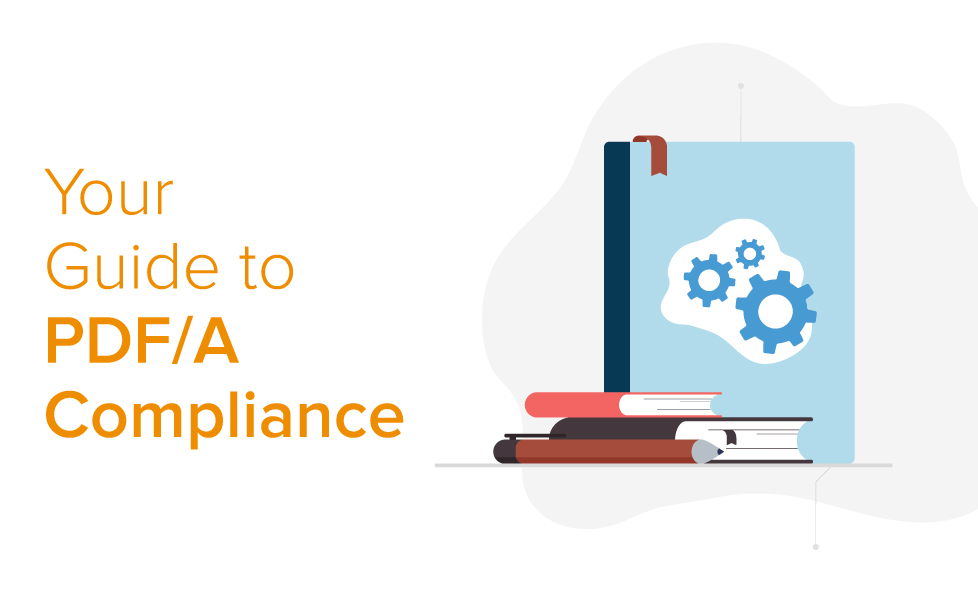Your Guide to PDF/A Compliance

PDF/A was conceived to fill a need for a long-term reproducible document format. Rival formats such as TIFF already existed for archiving purposes, but the content in the document wasn’t searchable. It also generally took up a lot of space due to being lossless. Read on as we give you the insider’s guide to what PDF/A compliance can mean for your company.
Contents
What is PDF/A?
PDF/A is a version of PDF designed for archiving. It follows ISO standard 19005 and its purpose is to ensure that documents appear the same on any device accessing them in the long term.
There are a number of PDF/A sub-standards, and each has specific requirements to meet them:
- PDF/A-1 (PDF/A-1a, PDF/A-1b)
- PDF/A-2 (PDF/A-2a, PDF/A-2b, PDF/A-2u)
- PDF/A-3 (PDF/A-3a, PDF/A-3b, PDF/A-3u)
- PDF/A-4 (still in review)
PDF/A-1 specifies basic (B) and accessible (A) levels of conformance and has standards on colors, annotations, fonts and more.
PDF/A-2 includes specifications for JPEG 2000, layers, PDF packages, and attachments. It also includes a “u” variant which relates to Unicode and ensures that a user can perform a text search/extraction.
PDF/A-3 is largely similar to A-2 but allows non-PDF file types to be embedded or attached to conforming documents.
PDF/A-4 is still in the works and is expected to be released later in 2019.
What does “PDF/A compliant” mean?
PDF/A compliant means your file meets the requirements of the PDF/A format. The most basic PDF/A requirements are as follows:
- All content is embedded (fonts, colors, text, images, etc.) and does not contain audio/video
- The file is not encrypted
- The file follows standards-based metadata
- Form fields that are interactive must have an appearance dictionary
- The file does not contain JavaScript
- The file does not contain references to external content
- The file does not contain XFA forms
Different conformance levels have additional requirements that have to be met in order to be compliant. Once you have met the requirements of a particular conformance level, you can verify the compliance by checking the properties of the document.
How can I use PDF/A?
PDF/A is excellent for preserving your files in the long term. You no longer have to print and store physical copies of your documents. You can also search through these documents in seconds instead of having to go through files individually. This is due to the fact that the document metadata standard requires a much more consistent and organized structure.
PDF/A is a legal requirement in many industries and countries. Whether government, legal, healthcare or otherwise, many laws necessitate the use of PDF/A. In the US Supreme Court, for example, Rule 29.5 states, “Documents submitted through the electronic filing system should be in the PDF/A format.” In the healthcare industry, “legal certainty” means that proof such as a recorded digital signature must be accessible and on record for providers in this field, showing a solution like PDF/A is critical to document workflows.
Reasons to use PDF/A:
Using the PDF/A format offers a number of different benefits for your company:
- Archiving – Store your documents in an internationally recognized format.
- Full-text search – Search for a database-stored string of text in your documents for fast access.
- Long term accessibility – Rest in the knowledge that your documents will appear now as they will in a decade or a century.
- Software-agnostic – Documents will appear the same regardless of what software you use to view them.
- Binding legally – Digital signatures recorded in the PDF/A file can be enforceable by law.
PDF/A use cases
PDF/A is perfectly suited to archiving your documents. Below are some industry use case examples:
- Digital documents – Example: a legal firm that wants to covert all of their legal documents to PDF/A for archiving and compliance purposes.
- Documentation – Example: a bank that has a brochure for a service they used to offer can refer to the exact terms and conditions of the service in the distant future.
- Collaborating – Example: a construction company where engineers share drafts of a document and store the finished version in PDF/A for long term accessibility.
- Email/mail – Example: a healthcare provider that wants to use PDF/A to automatically archive all emails/letters that they receive from patients in order to access them quickly and provide a better service.
- Physical documents (migrating) – Example: an insurance company that wants to create a digital archive of all printed invoices so they can quickly search them in future when necessary which improves productivity.
The problem with PDF/A alternatives
In the past, and unfortunately in some cases the present, companies have used TIFF files as the standard among alternatives. The problem with this is that TIFF files are often very large in size, not as secure as PDF/A, not searchable and do not contain metadata. This coupled with the fact that it does not meet the necessary compliance laws for different industries, particularly governments, means that this is not a worthwhile alternative for a company with the future in mind.
The Word format is another popular choice but also has many limitations in archiving. For one, it is not the ISO standard for archiving. Additionally, it cannot handle graphics safely (always), and does not produce consistent colors or handle fonts consistently.
JPEG is another alternative but similarly is not the ISO standard. It also doesn’t contain fonts, searchable text or structured data, leaving PDF/A once again in a league of its own.
Foxit PDF SDK PDF/A compliance capability
The latest Foxit PDF SDK provides APIs to convert a PDF to be compliant with PDF/A standards or verify whether a PDF is compliance with PDF/A. It supports all PDF/A versions and can convert at industry-leading speeds whether on a server or end user application. We’re experts in PDF/A, so get in touch below today for a free trial.

